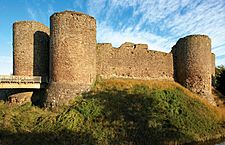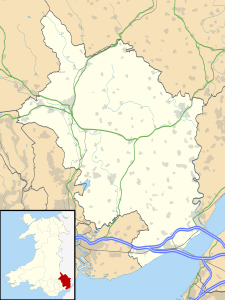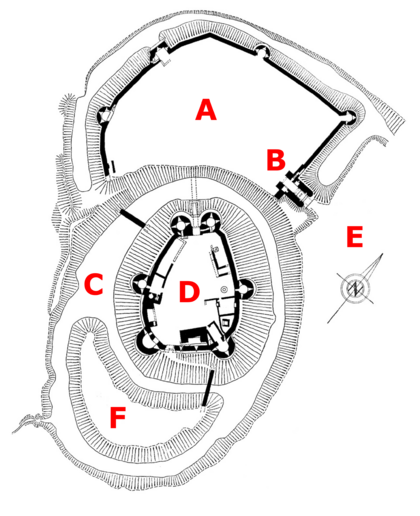White Castle, Monmouthshire facts for kids
Quick facts for kids White Castle |
|
|---|---|
| Monmouthshire, Wales | |

Gatehouse and curtain wall of the inner ward, seen from the outer ward
|
|
| Coordinates | 51°50′43″N 2°54′10″W / 51.8454°N 2.9029°W |
| Site information | |
| Controlled by | Cadw |
| Open to the public |
Yes |
| Condition | Ruined |
| Site history | |
| Materials | Red sandstone |
| Events | Norman invasion of Wales |
White Castle (Welsh: Castell Gwyn) is a ruined castle in Monmouthshire, Wales. It was also known as Llantilio Castle long ago. The Normans, who invaded England in 1066, built this castle. They wanted to protect the route from Wales to Hereford.
The castle was likely ordered by William fitz Osbern, the Earl of Hereford. It first had three big earth mounds with wooden defenses. In 1135, a big Welsh uprising happened. In response, King Stephen grouped White Castle with two other castles, Grosmont and Skenfrith. Together, they were called the "Three Castles". This group of castles helped defend the area from Welsh attacks for many centuries.
King John gave the castle to a powerful official, Hubert de Burgh, in 1201. For the next few decades, the castle changed hands many times. Hubert, the de Braose family, and the King all owned it at different times. During this period, White Castle was rebuilt with strong stone walls, towers, and gatehouses. A historian named Paul Remfry called it "a masterpiece of military engineering."
In 1267, the castle was given to Edmund, the Earl of Lancaster. It stayed with the Earls, and later the Duchy, of Lancaster until 1825. When King Edward I conquered Wales in 1282, White Castle became less important for defense. By the 1500s, it was no longer used and became a ruin. Today, the Welsh heritage group Cadw looks after the castle. It was placed in state care in 1922.
Contents
History of White Castle
Building the First Castle (1000s-1100s)
White Castle was built after the Normans invaded England in 1066. Soon after, the Normans moved into the Welsh Marches. This was the border area between England and Wales. William the Conqueror made William fitz Osbern the Earl of Hereford. Earl William took control of towns like Monmouth and Chepstow.
The Normans used castles a lot to control the Welsh people. They also built new towns and showed their power over the lands. White Castle was first called Llantilio Castle. It was one of three castles built in the Monnow valley around the same time. Earl William might have built them himself. They were meant to protect the route from Wales to Hereford. The castle also watched over the area of Llantilio Crossenny and the River Monnow.
The first castle was made of earth and wood. It had three big earth mounds. These formed an inner and outer area, called a ward. A special defense called a hornwork protected the main entrance. A mill was also built nearby to grind grain for the castle's soldiers.
The Earl of Hereford's lands in the area slowly broke apart. This happened after William's son, Roger de Breteuil, rebelled in 1075. In 1135, a big Welsh revolt started. King Stephen then changed how the lands were controlled. He brought White Castle, Grosmont, and Skenfrith back under the King's control. They became known as the "Three Castles".
Fighting with the Welsh continued. In the 1170s, powerful families like the de Mortimer and de Braose attacked their Welsh rivals. This led to a Welsh attack on nearby Abergavenny Castle in 1182. Because of this, the King prepared White Castle for an attack. Between 1184 and 1186, about £128 was spent on the castle. This money likely paid for a stone curtain wall around the inner ward. A small stone keep was also added to the defenses.
Rebuilding and Changing Hands (1200s-1600s)
In 1201, King John gave the Three Castles to Hubert de Burgh. Hubert was a minor landowner who became a very powerful royal official. At this time, White Castle was mainly a military fort. It held soldiers and supplies like arrows and crossbow bolts. The castle was not very comfortable. A historian said the conditions were likely "miserable" and "unpleasant."
Hubert started to improve his new castles. But he was captured while fighting in France. While Hubert was a prisoner, King John took back the Three Castles. He gave them to William de Braose, who was Hubert's rival. King John later fell out with William and took his lands in 1207. But William's son, also named William, took the castles back during a war called the First Barons' War.
After being freed, Hubert became powerful again. He became the King's chief judge, called the royal justiciar. He was also made the Earl of Kent. He finally got the Three Castles back in 1219, during the reign of King Henry III. Hubert lost power in 1232, and the castles were taken from him. They were put under the control of Walerund Teutonicus, a royal servant. Hubert made up with the King in 1234, and the castles were briefly returned. But he fell out with King Henry III again in 1239, and Walerund got them back. Walerund built a new hall, buttery, and pantry at the castle in 1244. In 1254, White Castle and its sister forts were given to King Henry's oldest son, Prince Edward. Prince Edward later became King.
During the 1200s, the castle was almost completely rebuilt. Historians have different ideas about when this happened. Some think it was in the 1250s and 1260s. This work would have included tearing down the old keep. A new gatehouse and four mural towers were built. The outer ward was also made stronger with a stone wall and its own gatehouse. Another historian, Paul Remfry, believes the work happened earlier. He thinks it was done in two stages between 1229–1231 and 1234–1239. Around this time, the castle was first called "White Castle." This was because its outer walls were covered in white plaster.
The Welsh threat continued. In 1262, the castle was prepared for an attack. This was in response to Prince Llywelyn ap Gruffudd's attack on Abergavenny. The castle's leader, Gilbert Talbot, was told to fill Grosmont with soldiers "by every man, and at whatever cost." Luckily, the attack did not happen.
Edmund, the Earl of Lancaster, was given the Three Castles in 1267. For many centuries, these castles were held by the Earls, and later the Duchy, of Lancaster. King Edward I's conquest of Wales in 1282 made White Castle less important for military use. However, it was still used to manage the surrounding area. It also helped gather soldiers for the army. Not much more building work was done on the castle. One of the gatehouse towers was repaired at some point. Repairs were also made to the chapel tower and gatehouse under King Henry VI. By 1538, White Castle was no longer used and became a ruin. A description from 1613 said it was "ruynous and decayed."
Modern Times (1700s-Today)
In 1825, the Three Castles were sold to Henry Somerset, the Duke of Beaufort. In 1902, Henry Somerset, the 9th Duke, sold White Castle to Sir Henry Mather Jackson. In 1909, a report said that Sir Henry had removed ivy from the castle. It was now in good condition. An old woman apparently looked after the site and charged visitors to enter.
The castle was placed under the care of the state in 1922. Today, Cadw, the Welsh heritage agency, manages White Castle. It is protected by UK law as a grade I listed building. This means it is a very important historical site.
Castle Design and Features
White Castle sits on a hill near Llantilio Crossenny village. It looks out over the land around it. The castle was mostly built in the 1200s. It has a central inner ward, which is the main area. To the south, there is a crescent-shaped hornwork. To the north, there is an outer ward. The castle is built from red sandstone.
The outer ward was once much larger. It stretched further around the castle to the east. But only small parts of these old earth defenses remain. Today, you enter the castle from the north-east. Before the 1200s, the entrance was on the south side. The historian Paul Remfry thinks the castle is "a masterpiece of military engineering" for its time.
The outer ward is about 320 feet (98 m) long and 170 feet (52 m) wide. You get in through a gatehouse on the eastern side. A stone curtain wall, a dry ditch, and four mural towers protect it. The gatehouse is still about 16 feet (5 m) high. It used to have a portcullis (a heavy metal gate) and a drawbridge. Three of the towers were round. One was rectangular and probably used as living space for an official. There was a large building, likely a barn, about 115 feet (35 m) by 66 feet (20 m) in the outer ward. There were also smaller buildings, but they are all gone now.
The inner ward is about 150 feet (46 m) long and 110 feet (34 m) wide. A deep, water-filled moat dug out of the rock protects it. The curtain wall has four round, four-story towers and a gatehouse. There were living buildings built along the inside of these defenses. The four-story gatehouse has two round towers next to it. It also would have had a portcullis and a drawbridge. The castle's constable or steward would have used this gatehouse.
East of the gatehouse were the castle's hall and the constable's living areas. There was also a chapel, partly inside one of the towers. The remains of an earlier keep, service buildings, and the kitchen block were also there. Only the foundations of these buildings remain today. A postern gate (a secret back gate) in the inner ward leads to the southern hornwork. This hornwork would have been connected by a wooden bridge. It was protected by wooden defenses and towers, with later stone additions. Only traces of these remain.
White Castle has unusual arrow loops. These are narrow openings in the walls for archers to shoot through. The two parts of a normal cross-shaped loop are offset vertically here. One side is higher than the other. Historians have different ideas about how well this design worked. They might have helped defenders shoot down the slopes around the castle. Or they might have given better protection from incoming arrows. However, tests in 1980 showed they were very easy to hit with incoming shots.





